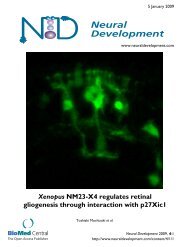PDF - Neural Development
PDF - Neural Development
PDF - Neural Development
You also want an ePaper? Increase the reach of your titles
YUMPU automatically turns print PDFs into web optimized ePapers that Google loves.
Kizil et al. <strong>Neural</strong> <strong>Development</strong> 2012, 7:27 Page 7 of 13<br />
http://www.neuraldevelopment.com/content/7/1/27<br />
Figure 4 cxcr5 is required and sufficient for regenerative neurogenesis. (A) Heat shock and BrdU scheme for neurogenesis assay in the<br />
unlesioned telencephalon. After a sham operation, three daily heat shocks were given before a 10-hour BrdU pulse and sacrifice at 30 days after<br />
the sham operation. (B-D) HuC and BrdU immunohistochemistry (IHC) and 4,6-diamidino-2-phenylindole (DAPI) counterstaining on unlesioned<br />
telencephalons from non-transgenic (B), Tg(hsp:egfp-t2a-dncxcr5) (C) and Tg(hsp:egfp-t2a-FLcxcr5) (D) animals. Primed and double-primed images<br />
are single channels for BrdU and HuC. (E) Quantification graph for relative numbers of HuC and BrdU double positive cells (newborn neurons) in<br />
unlesioned telencephalons. Transgenic misexpression of cxcr5 does not alter the constitutive levels of neurogenesis in the adult zebrafish<br />
telencephalon. (F) Heat shock and BrdU scheme for neurogenesis assay in lesioned telencephalons. After the lesion, three daily heat shocks were<br />
given before a 10-hour BrdU pulse and sacrifice at 30 days after lesioning. (G-I) HuC and BrdU IHC and DAPI counterstaining on unlesioned<br />
telencephalons from non-transgenic (G), Tg(hsp:egfp-t2a-dncxcr5) (H) and Tg(hsp:egfp-t2a-FLcxcr5) (I) animals. Primed and double-primed images<br />
are single channels for BrdU and HuC. (J) Quantification graph for relative numbers of newborn neurons in lesioned telencephalons. Transgenic<br />
misexpression of dominant negative variant of cxcr5 significantly reduces, and full-length cxcr5 significantly increases, the number of newborn<br />
neurons after lesioning in the adult zebrafish telencephalon. Scale bars 25 μm; n = 4 telencephalons for each analysis.<br />
stage of the RGC at which it is competent to proliferate<br />
but is not actually in the cell cycle, or cxcr5 has a<br />
proliferation-independent role in those glial cells. In<br />
adult brains, glial cells are known to be heterogeneous<br />
in terms of their proliferation and progenitor characteristics<br />
[1,2,6,12,15]. Therefore, cxcr5 may either be<br />
expressed in glial cells with different inherent propensities<br />
to become neurogenic and proliferative or it can<br />
be a part of the mechanism that establishes the functional<br />
heterogeneity. It is not clear whether the constitutive<br />
neurogenesis and the injury-induced neurogenesis<br />
use the same progenitor cells to form neurons by simply<br />
enhancing the rate of cell divisions, or whether there are<br />
reserve stem cells that are activated after injury. Given<br />
that we observed an effect of cxcr5 misexpression on<br />
proliferation and neurogenesis only after the injury, it is<br />
possible that the roles of cxcr5 we identified are associated<br />
with the regenerative response. This suggests that<br />
the expression of cxcr5 in unlesioned brains may either<br />
be relevant to a permissive proliferative and neurogenic<br />
capacity of the RGCs or be a physiological function independent<br />
of RGC proliferation. However, it is currently<br />
not possible to distinguish between these alternatives<br />
with our current level of understanding. Long-term<br />
single-cell lineage tracing experiments with a cxcr5-positive<br />
non-proliferative RGC will help us understand<br />
whether under homeostatic conditions, cxcr5-positive<br />
glial cells initiate cell division and form neurons, or<br />
whether they are required for an as-yet unidentified role<br />
in the glial cells.<br />
The dominant negative variant of cxcr5 did not affect<br />
cell proliferation in unlesioned or lesioned telencephalons.<br />
Similarly, Tg(hsp:EGFP-T2A-dncxcr5) animals did<br />
not alter their neurogenesis levels after heat shocks in<br />
unlesioned conditions. However, when overexpressed,<br />
this variant reduced the production of neurons after the<br />
lesion. These findings pose four possible explanations.<br />
First, cxcr5 may not be required for cell proliferation but<br />
may be required for differentiation of RGCs to neurons.<br />
Second, the different effects of dominant-negative cxcr5<br />
could be due to the expression levels of the Tg(hsp:<br />
EGFP-T2A-dncxcr5) transgenic cassette. The dose of the<br />
transgene expression might not be sufficient to compete<br />
with the endogenous levels of cxcr5, which could be adequate<br />
to fulfil the cognate function in the cells and obscure<br />
any loss-of-function effect. However, we believe<br />
that this option is unlikely as by injecting cxcr5 morpholinos<br />
using CVMI to the adult fish brain, we ruled out




